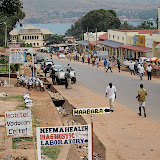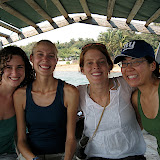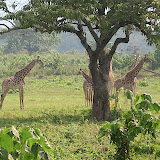I spent today shadowing a nurse-midwife in the maternity ward of Maweni hospital – an incredible experience.
The maternity ward is set up like a shotgun house – each room leads directly to the next, going straight back (so if you fired a shotgun, the bullet would travel through each room). The first room you enter into is the recovery/ward room. 18 saggy old metal beds line the walls. Today every bed was full – women sleeping with a baby wrapped in bright kangas like a present at the foot of the bed or next to them, awake mothers breast feeding, and then the recovering women – laying on their side staring into space, recovering from a c-section or suffering from malaria, the drained and exhausted women recovering from PPH, and the vacant expressions of the women (around 3) where the brightly colored packages were conspicuously absent. Around 12 visiting hours began, and the ward turned into a zoo. Each woman had an average of four women visitors, each carrying kangas, tea, and porridge to fortify the new mothers. They held the baby, bugged the nurses, fed the women, and provided support. It seemed like a very necessary part of postpartum care for these women. A few men came, hanging back and maybe holding the baby. It was obvious that this was women’s territory. When the visiting hour was over, the mass of people went outside to wait for the next visiting time, which explains why there are always groups of ladies with thermoses and kangas sitting in the (open air) corridor outside of the maternity ward.
The next room is the nurses station. It, like the ward, had chipping cream and sea foam painted concrete walls, a concrete floor, a single fluorescent bulb, and a rusty metal fan. It’s a busy room, with people (not just nurses, but patients too since it connects all the rooms of the ward) coming and going. They don’t have a stapler, so they use medical tape to hold patient’s papers together (I’m giving them one when I go to observe again next Monday).
The room beyond that is the delivery room. It has four metal beds with plastic pads on them. When women deliver they put a plastic sheet down, which they reuse wash between patients. There’s also a rusty little box on wheels that they use to hold the babies after delivery. There’s only room for one, so if more than one newborn is present the others have to lay on the weighing table next to wrappers and instruments. Beyond the delivery room is the ANC room, where women who have begun labor but aren’t ready to deliver wait until they were ready. The ward was so crowded when I was there that the overflow stayed in this room.
So today there were over 26 patients – 18 in the ward, 4 in the ANC room who had already delivered, and a few that showed up to deliver. There were five deliveries during the 8 hours I was there (all but 1 were delivered in the last two hours). There was one nurse/midwife and one public health nurse on duty.
I spent a lot of the day alternating between being really bored and being incredibly overwhelmed. When I first arrived, a woman was going in for a c-section. They invited me into the theater, but I declined – didn’t feel quite ready for that. I went back to the delivery room and watched women labor for the next few hours, taking breaks to watch the nurse give transfusions and injections. I saw several vaginal exams – one of them I was instructed to step back during the middle of it, and a few seconds later her water broke flooding the table and the floor. Later I was standing just observing the room, when I got pushed out of the way. I looked back, and a couple feet from where I was standing, a head was emerging. I saw the baby be born, and then the n/midwife took the baby and started cleaning it. She ignored the mom, and when I looked back over my shoulder, I saw another head appearing – twins! I tapped the nurse on the shoulder, and she went back over to deliver the other twin. They had no idea that there were two babies there – no ultrasounds here and archaic methods of listening to heartbeats, so usually twins are a surprise here. The second twin was much smaller, and had to be put on oxygen. Meanwhile, the on-call doctor for the hospital (the one) examined a woman that had been laboring for over 24 hours. He said that the heartbeat on the baby was beginning to change, and he needed to perform a c-section. So I attended a cesarean. They put me in scrubs (not sure if they were clean or not, there was a bit of scurrying to find them) and wrapped my face in gauze (no extra masks). The doctor had me stand two feet from his side, and I watched the procedure. I won’t gross you out with the details, but it was really interesting. The baby had gone into distress, and it’s head was about a foot long from being stuck in the birth canal for so long. They spent ten minutes resuscitating the infant, and thankfully he was fine.
After that, I was done – a long day! It made me realize I definitely don’t want to be a doctor (all that sewing looked really monotonous), and maybe don’t really want to be a nurse either (the operation didn’t bother me, but drawing blood and tying the umbilical cord did). I think I do really want to be a doula, because all I wanted to do during the hours I spent with laboring women (4 at once at one point) was support them and rub their back and help reduce their pain. It was an incredible day, and I’m fortunate enough to be going back for another observation with one of our interviewers who is also a nurse-midwife at the hospital next week.
What amazed me a lot was how self-sufficient the mother's were. There was definitely no coddling involved - in fact the nurse slapped a laboring woman on the but a few times to get her to move. Among the women's belongings were thermoses of tea, and in between contractions they would pour themselves a cup. The woman who had twins barely made a peep during delivery, and showed no surprise when she delivered twins. In fact, she never spoke to the nurses. After delivering the placenta and getting cleaned up, she wrapped herself in a kanga and, without a work, walked into the ward. She looked utterly exhausted, and never asked about her babies. Her mother came in later to retrieve them and take them back to the ward.



